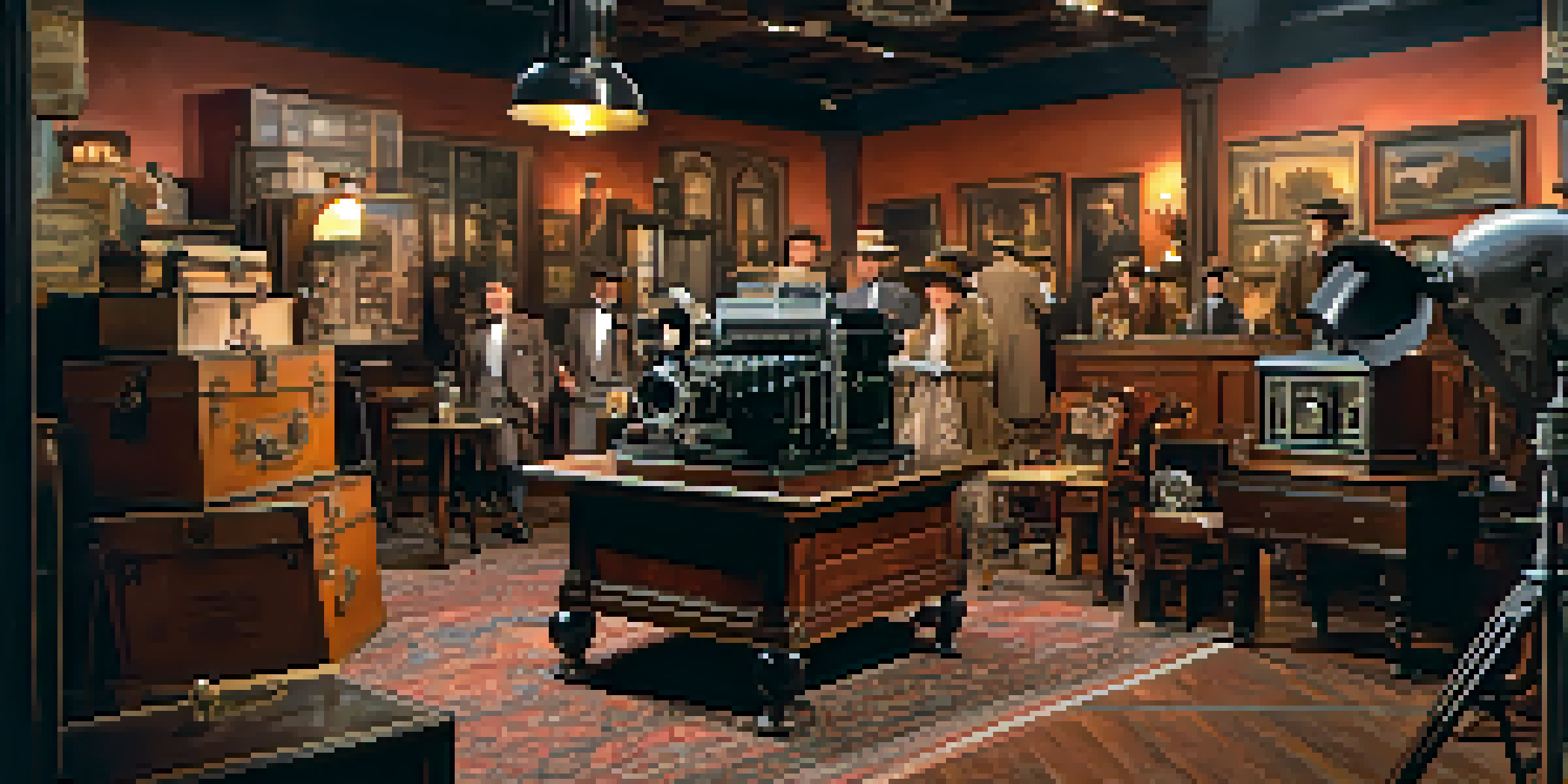Hollywood's Impact on Cinema Styles Around the World

The Birth of Hollywood and Its Global Reach
Hollywood emerged as the epicenter of cinema in the early 20th century, quickly establishing a powerful influence on global film production. With its massive studios, celebrity culture, and innovative storytelling, Hollywood became synonymous with the film industry itself. As films began to cross borders, they carried with them unique styles, narratives, and marketing techniques that influenced local cinemas around the world.
Cinema is a matter of what's in the frame and what's out.
The allure of Hollywood's glamorous lifestyle attracted filmmakers and audiences alike, leading to a significant cultural exchange. Countries began to adopt Hollywood's production methods, narrative structures, and even star systems to enhance their own cinematic offerings. This exchange sparked a creative dialogue that would shape the evolution of film styles globally.
While some filmmakers embraced Hollywood's influence, others sought to develop their own distinct cinematic languages. Nevertheless, the impact of Hollywood remained undeniable as it set the standard for both commercial success and artistic ambition in cinema.
Narrative Structures: The Hollywood Formula
One of the most significant contributions of Hollywood to global cinema is the establishment of the three-act structure. This narrative formula, characterized by a clear setup, confrontation, and resolution, has become a staple in storytelling worldwide. Filmmakers from various countries have adopted this structure to create engaging plots that resonate with audiences, regardless of cultural background.

By analyzing popular Hollywood films, directors around the globe have learned the importance of pacing, character arcs, and conflict resolution. For example, films from Bollywood to Nollywood often incorporate elements from Hollywood's narrative style while infusing their own cultural nuances and themes. This blending of styles has led to innovative storytelling techniques that capture the essence of diverse cultures.
Hollywood's Global Influence
Hollywood has significantly shaped global cinema through its narrative structures, visual styles, and genre innovations.
However, while the Hollywood narrative formula has been widely embraced, some filmmakers intentionally subvert these conventions to challenge audience expectations. This creative pushback has paved the way for unique storytelling that reflects local experiences, demonstrating that influence can be both transformative and limiting.
Visual Styles: Hollywood's Cinematic Language
Hollywood has played a pivotal role in shaping visual aesthetics in cinema, introducing techniques like dramatic lighting, dynamic camera movements, and elaborate set designs. These stylistic choices have influenced filmmakers worldwide, leading to the adoption of high production values that enhance storytelling. As a result, audiences now expect a level of visual sophistication across various film industries.
Film is a powerful means of communication; it transcends barriers of language and culture.
For instance, the use of vibrant colors and elaborate costumes in films like 'La La Land' has inspired directors in countries such as India and Mexico to elevate their visual storytelling. By understanding and incorporating Hollywood's cinematic language, filmmakers can create visually captivating narratives that draw viewers into their worlds. This fusion of styles has led to a rich tapestry of global cinema that blends various cultural elements.
However, this influence also raises questions about the homogenization of film aesthetics. As local filmmakers adopt Hollywood's visual techniques, there is a risk of losing unique cultural identities within their films. The challenge lies in balancing the allure of Hollywood's visuals with the authenticity of local storytelling.
Genre Evolution: Hollywood's Influence on Film Categories
Hollywood has been instrumental in popularizing various film genres, from action and romance to horror and science fiction. This genre proliferation has had a profound impact on global cinema, encouraging filmmakers to explore and innovate within established categories. As a result, we see local filmmakers experimenting with genre conventions to create films that resonate with their audiences while still paying homage to Hollywood's influence.
For example, Korean cinema has successfully blended the horror genre with dark comedy, producing films like 'Parasite' that have garnered international acclaim. Similarly, Bollywood has taken the musical genre to new heights, incorporating traditional dance and cultural elements that set it apart from its Western counterparts. These genre adaptations reveal the dynamic nature of cinema and the power of cross-cultural exchange.
Cultural Exchange in Filmmaking
Collaborative projects between Hollywood and international filmmakers foster rich cultural exchanges that enhance storytelling.
However, while Hollywood's genres can inspire creativity, they can also create pressure to conform to certain expectations. Filmmakers must navigate this fine line between embracing popular genres and remaining true to their cultural narratives, which can lead to innovative and unexpected cinematic experiences.
Cultural Exchange: Collaboration and Co-Productions
In recent years, Hollywood has increasingly engaged in collaborative projects and co-productions with filmmakers around the world. This exchange not only enhances the storytelling potential but also allows for a rich blending of cultural influences. Through these partnerships, filmmakers can share resources, expertise, and diverse perspectives, resulting in films that appeal to a broader audience.
A prime example of this collaboration is the co-production of the film 'The Great Wall,' which united American and Chinese filmmakers to create a visually stunning epic that reflects both cultures. Such projects highlight the potential for cross-cultural storytelling that resonates on a global scale while showcasing the richness of local traditions.
However, these collaborations can sometimes lead to cultural appropriation concerns, where local narratives are overshadowed by Hollywood’s commercial interests. Striking a balance between artistic collaboration and cultural respect is essential for the future of global cinema.
The Future of Cinema: Hollywood's Ongoing Influence
As we look ahead, Hollywood's influence on global cinema continues to evolve, especially with the rise of streaming platforms. These platforms have democratized access to films from different cultures, allowing audiences to explore diverse cinematic styles. This shift has empowered filmmakers to push boundaries and experiment with storytelling in ways that were previously unimaginable.
Moreover, the growing popularity of international films in the mainstream, such as 'Squid Game' and 'Roma,' signifies a shift in audience preferences. Viewers are increasingly seeking authentic stories that reflect a variety of experiences, leading to a more inclusive cinematic landscape. Hollywood must adapt to this changing environment by embracing diversity and fostering new voices in storytelling.
Technology's Impact on Film
Advancements in technology, like CGI and drone usage, have transformed global filmmaking, offering new creative opportunities while raising authenticity concerns.
Ultimately, the future of cinema lies in collaboration, innovation, and the blending of diverse cultural influences. As Hollywood continues to inspire filmmakers worldwide, it will be crucial to ensure that local stories are told authentically, preserving the essence of each culture while celebrating the art of cinema as a global experience.
The Role of Technology in Shaping Film Styles
Hollywood has always been at the forefront of technological innovation, from the introduction of sound and color to the latest advancements in CGI and virtual reality. This relentless pursuit of new technologies has significantly influenced film styles around the world, pushing filmmakers to explore new creative possibilities. As a result, we see a heightened emphasis on visual effects and immersive storytelling in global cinema.
For instance, the use of drone technology in filmmaking has revolutionized how stories are told, offering breathtaking aerial shots that enhance the narrative. Filmmakers in countries like New Zealand and India have embraced these advancements, creating visually stunning films that captivate audiences worldwide. This technology-driven evolution allows for more dynamic and engaging storytelling, regardless of cultural context.

However, reliance on technology also raises questions about authenticity and the essence of storytelling. While advancements can enhance visual appeal, it’s essential for filmmakers to remember the heart of their narratives and the cultural significance behind their stories. Balancing innovation with authenticity will be crucial for the future of cinema.